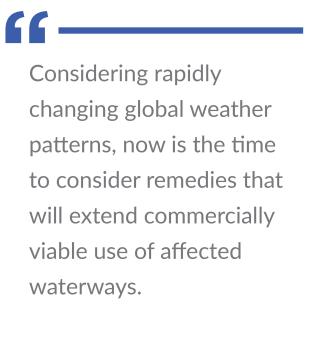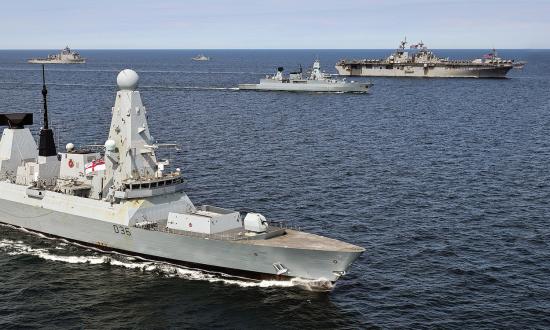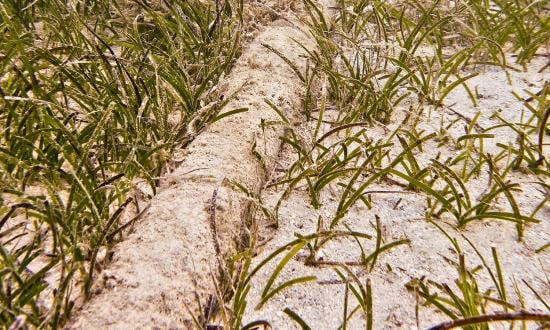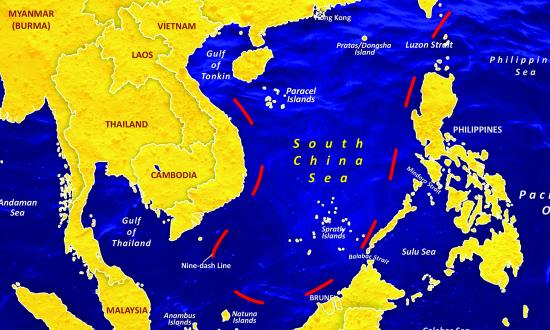Advances in naval architecture and marine engineering have made modern cargo vessels more productive and cost-efficient. Specifically, truck transportation is nine times more costly than shipping by water. By rail it is six times more. Unfortunately, as the climate has warmed, severe drought events that affect water levels in navigable waterways have become more frequent.
The Mississippi River Basin produces 92 percent of U.S. agricultural exports. In October 2022, a “flash drought” reduced river water levels to a historic low, stopping navigation at various points along the river. At one point, more than 2,000 cargo barges were stranded. Then, in May 2023, record rains raised the river to one of its highest recorded levels. In both cases, economic consequences were serious.
Europe depends on 26,000 miles of riverine waterways to carry up to 80 percent of its cargo. Most is transported on the Rhine (800 miles long) and Danube (1,700 miles long). There also has been a drought in Europe since 2018. In 2022, many areas of these marine highways were unusable when water depths became too shallow for safe navigation. The depth limitations were for short stretches, resulting in these rivers being segmented into shorter, navigable lengths. Smaller vessels were still used in some places, but they, too, became unusable as the drought persisted.
While regular maintenance dredging is ongoing, extensive corrective operations are often too costly. This is a losing proposition as more frequent droughts reduce waterflow into rivers faster than they can be drained.
Land-use conflicts make building mitigating infrastructure difficult. Moving cargos by trucks and railroads will not make up for the loss of navigable waterways. For example, a single barge can carry as much grain as 40 trucks. There are no easy long-term solutions. The volume of traditional waterborne commerce in Europe will be reduced from current levels.
In 2022, extreme drought in China caused large areas of the Yangtze River to dry up, halting all shipping. Considering China’s pivotal role in the global economy, cascading consequences for world trade were significant. Even after the current drought eases, this situation will return in future years.
The Panama Canal, which carries 5 percent of global maritime commerce, also is a rain-dependent waterway. Rainfall from the mountainous spine of Panama is the primary source for the canal’s Gatun Lake. The lake’s huge volume provides the gravitational water flow that makes the canal and its 12 locks work.
In recent years, rainfall at times has been insufficient for the largest ships to pass through fully loaded. Yet, it was only six years ago that Panama finished a ten-year, $5 billion effort to widen the canal to facilitate passage of larger ships. Understandably, the upgrade requires even more water from Gatun Lake.
With the new locks, the Panama Canal Company hoped to attract more traffic and increase revenue from canal operations. This was not to be. In May 2023, because of severe drought, the company set new maximum draft rules for ships using the canal. While it had been 47.5 feet, it is now 44 feet. Larger vessels can still use the canal, but they must transit with less cargo to comply with water depth restrictions. Each inch of reduced draft translates into revenue loss for vessel operators. Eventually, they may choose to not use the canal at all.
Drought-driven navigation restrictions for the Mississippi River, China, and Europe are not year-round events now, but they will be. These are examples of problems that affect hundreds of waterways worldwide.
Considering rapidly changing global weather patterns, now is the time to consider remedies that will extend commercially viable use of affected waterways. Ships with less draft will continue to use the Panama Canal, but some larger ones will choose alternate routes. The canal operator will have to carefully set new tariffs to avoid more revenue loss. On the Mississippi and Chinese and European rivers, it is hard to see how much reduction in vessel size can be achieved without affecting economies of scale in moving the world’s trade.








